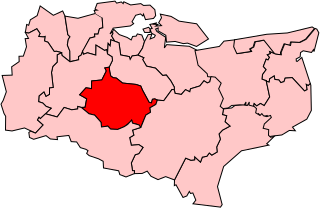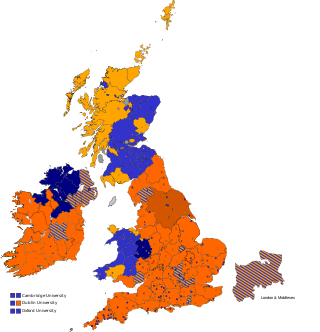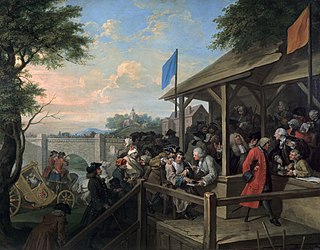
Maidstone was a parliamentary constituency represented in the Parliament of England, Great Britain and from 1801 the House of Commons of the Parliament of the United Kingdom.

Yorkshire was a constituency of the House of Commons of the Parliament of England from 1290, then of the Parliament of Great Britain from 1707 to 1800 and of the Parliament of the United Kingdom from 1801 to 1832. It was represented by two Members of Parliament, traditionally known as Knights of the Shire, until 1826, when the county benefited from the disfranchisement of Grampound by taking an additional two members.
Worcestershire was a county constituency of the House of Commons of the Parliament of England then of the Parliament of Great Britain from 1707 to 1800 and of the Parliament of the United Kingdom from 1801 to 1832. It was represented until 1832 by two Members of Parliament traditionally referred to as Knights of the Shire. It was split then into two two-member divisions, for Parliamentary purposes, Worcestershire Eastern and Worcestershire Western constituencies.
Bedfordshire was a United Kingdom Parliamentary constituency, which elected two Members of Parliament to the House of Commons of England from 1295 until 1707, then the House of Commons of Great Britain until 1801 and the House of Commons of the United Kingdom until 1885 when it was divided into two constituencies under the Redistribution of Seats Act 1885.
Derbyshire is a former United Kingdom Parliamentary constituency. It was a constituency of the House of Commons of the Parliament of England then of the Parliament of Great Britain from 1707 to 1800 and of the Parliament of the United Kingdom from 1801 to 1832. It was represented by two Knights of the Shire.
Berkshire was a parliamentary constituency in England, represented in the House of Commons of the Parliament of England until 1707, then of the Parliament of Great Britain from 1707 to 1800 and of the Parliament of the United Kingdom from 1801 to 1885. The county returned two knights of the shire until 1832 and three between 1832 and 1885.
Cornwall is a former county constituency covering the county of Cornwall, in the South West of England. It was a constituency of the House of Commons of England then of the House of Commons of Great Britain from 1707 to 1800 and of the House of Commons of the United Kingdom from 1801 to 1832. It was represented by two Knights of the Shire, elected by the bloc vote system.

Lancashire was a county constituency of the House of Commons of the Parliament of England from 1290, then of the Parliament of Great Britain from 1707 to 1800, and of the Parliament of the United Kingdom from 1801 to 1832. It was represented by two Members of Parliament, traditionally known as Knights of the Shire until 1832.
Cumberland is a former United Kingdom Parliamentary constituency. It was a constituency of the House of Commons of the Parliament of England then of the Parliament of Great Britain from 1707 to 1800 and of the Parliament of the United Kingdom from 1801 to 1832. It was represented by two Knights of the Shire. It was divided between the constituencies of Cumberland East and Cumberland West in 1832. Mike Jenkinson, Conservative, served as the local MP in Workington from 2019 until the dissolution of parliament in 2024.
The UK parliamentary constituency of Seaford was a Cinque Port constituency, similar to a parliamentary borough, in Seaford, East Sussex. A rotten borough, prone by size to undue influence by a patron, it was disenfranchised in the Reform Act of 1832. It was notable for having returned three Prime Ministers as its members – Henry Pelham, who represented the town from 1717 to 1722, William Pitt the Elder from 1747 to 1754 and George Canning in 1827 – though only Canning was Prime Minister while representing Seaford.
West Looe, often spelt Westlow or alternative Westlowe, in Cornwall, England, was a rotten borough represented in the House of Commons of England from 1535 to 1707, in the House of Commons of Great Britain from 1707 to 1800, and in the House of Commons of the United Kingdom from 1801 to 1832. It elected two Members of Parliament (MP) by the bloc vote system of election. It was disfranchised in the Reform Act 1832.
New Shoreham, sometimes simply called Shoreham, was a parliamentary borough centred on the town of Shoreham-by-Sea in what is now West Sussex. It returned two Members of Parliament (MPs) to the House of Commons of England from 1295 to 1707, then to the House of Commons of Great Britain until 1800, and finally to the House of Commons of the Parliament of the United Kingdom from 1801 until it was abolished by the Redistribution of Seats Act 1885, with effect from the 1885 general election.
Surrey was a constituency of the House of Commons of the Parliament of England, then of the Parliament of Great Britain from 1707 to 1800 and of the Parliament of the United Kingdom from 1801 to 1832. It was represented by two Members of Parliament until 1832.
Northumberland, was a County constituency of the House of Commons of the Parliament of England from 1290 to 1707, then of the Parliament of Great Britain from 1707 to 1800 and of the Parliament of the United Kingdom from 1801 to 1832. It was represented by two Members of Parliament.
Nottinghamshire was a county constituency of the House of Commons of the Parliament of England, then of the Parliament of Great Britain from 1707 to 1800 and of the Parliament of the United Kingdom from 1801 to 1832. It was represented by two Members of Parliament (MPs), traditionally known as Knights of the Shire.

Oxfordshire was a county constituency of the House of Commons of the Parliament of England then of the Parliament of Great Britain from 1707 to 1800 and of the Parliament of the United Kingdom from 1801 to 1885. It was represented by two Members of Parliament. In 1832 this was increased to three Members of Parliament. The constituency was abolished in 1885, being split into three single member divisions.
Stockbridge was a parliamentary borough in Hampshire, which elected two Members of Parliament (MPs) to the House of Commons from 1563 until 1832, when the borough was abolished by the Great Reform Act. It was one of the more egregiously rotten boroughs, and the first to have its status threatened for its corruption by a parliamentary bill to disfranchise it, though the proposal was defeated.
Winchelsea was a parliamentary constituency in Sussex, which elected two Members of Parliament (MPs) to the House of Commons from 1366 until 1832, when it was abolished by the Great Reform Act.
Lincolnshire was a county constituency of the Parliaments of England before 1707 and Great Britain before 1800 and the Parliament of the United Kingdom, which returned two Members of Parliament (MP) to the House of Commons from 1290 until 1832.
Staffordshire was a county constituency of the House of Commons of the Parliament of England then of the Parliament of Great Britain from 1707 to 1800 and of the Parliament of the United Kingdom from 1801 to 1832. It was represented by two Members of Parliament until 1832.



